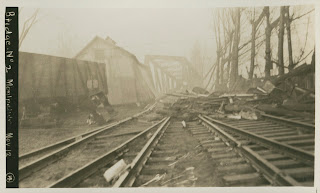Trainspotting can be something of an acquired taste, but for the true aficionado we present the Chase-Streeter collection. Formed mainly from gifts made by Judge
William Martin Chase, Dartmouth 1858, and Thomas W. Streeter, Dartmouth 1904, the collection focuses primarily on the early history of New England railroads. It consists of over fifteen hundred items ranging from charters, annual
reports of the various railroads to their stockholders, broadsides, and surveys
of railroads, many with maps, to hearings before legislative bodies and
pamphlets concerning legal disputes.
The collection also contains some more unique items such as a series of photographs documenting damage done to the Central Vermont Line during the 1938 hurricane. These images are eerily reminiscent of similar havoc caused by Hurricane Irene.
Other ephemeral items include a small set of timetables for various railroads, including several western lines, and a sampling of stock certificates for the New York Central Railroad and it's subsidiaries.
Search the Library catalog for all of the cataloged items in the collection. The items highlighted here are from Chase-Streeter New England C42 18 (hurricane damage), Chase-Streeter N45 1 (stock certificates) and Chase-Streeter U.S. General 10 (timetables).
Friday, March 22, 2013
Tuesday, March 19, 2013
Children at the Pole, with Penguins
Jack and Jill went up... to where? To the North Pole, naturally. We just acquired a very odd little book published not long after Cook purportedly reached the North Pole. The Children of the North Pole (London: George Harrap, 1914) is a sing-song verse describing the journey of parka clad Jack and Jill on their adventure to find the Pole. Along the way they ski, meet up with Eskimos, and encounter a friendly polar bear. But it is the trip home with the biggest surprise: dog sledding along they find themselves on Penguin Island.
The book's accordion fold structure allows it to open into kind of panorama. If you turn the book over and start reading from the other side, a prose version of the same story is told without pictures. In the prose version the penguins are explained. They came all they way north to congratulate the children and "to see whether the North Pole is like the South Pole." To Jack's question of whether there was a difference, the oldest penguin replied, "it is exactly like the South Pole, only it is day-time here when it is night with us."
Come take the journey by asking for Stef G614.C35 1914.
The book's accordion fold structure allows it to open into kind of panorama. If you turn the book over and start reading from the other side, a prose version of the same story is told without pictures. In the prose version the penguins are explained. They came all they way north to congratulate the children and "to see whether the North Pole is like the South Pole." To Jack's question of whether there was a difference, the oldest penguin replied, "it is exactly like the South Pole, only it is day-time here when it is night with us."
Come take the journey by asking for Stef G614.C35 1914.
Subscribe to:
Comments
(
Atom
)





